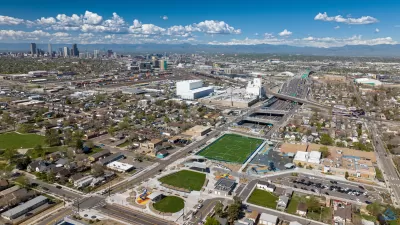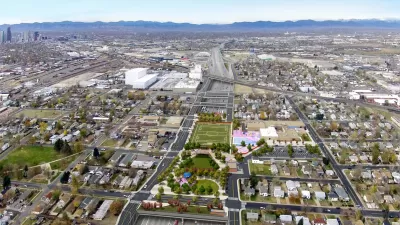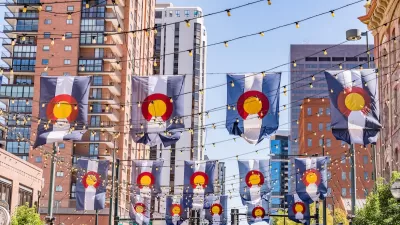Local residents fear rising housing costs and displacement with the opening of a new four-acre park built on a deck bridge over the newly reconstructed and widened I-70 interstate.

Denver’s new four-acre cover park, part of the controversial $1.2 billion reconstruction and widening of Interstate 70, opened earlier this month. The park project was designed to reconnect the long divided Globeville Elyria-Swansea, or GES, neighborhood, a predominantly Latino community in North Denver. “To outsiders, it seemed like a wonderful addition,” writes Raksha Vasudevan, contributing editor at High Country News.
But after four years of construction, 56 demolished homes to make way for the 1,000-foot stretch of widened highway, and $125 million to construct the park itself, local residents are not so sure. According to Vasudevan, by the time the park opened, realtors were already calling GES “Denver’s next hottest neighborhood—a chilling pronouncement for locals to hear,” as, “outside buyers meant higher prices.”
“[R]eimagining old infrastructure often invites unintended consequences. In what’s known as the ‘green space paradox,’ residents who historically lacked access to parks are the most likely to be displaced by rising housing costs once the greenery finally arrives. In central Dallas, a similar highway-capping park completed in 2012 hastened the development of luxury apartments, leading to rents that are among the region’s highest.”
While GES residents agree the community could use more green space—previously, only about 55 acres of parkland existed in the nearly five-square-mile neighborhood—they don’t feel gentrification and displacement is a fair trade-off.
FULL STORY: North Denver’s green space paradox

Study: Maui’s Plan to Convert Vacation Rentals to Long-Term Housing Could Cause Nearly $1 Billion Economic Loss
The plan would reduce visitor accommodation by 25,% resulting in 1,900 jobs lost.

North Texas Transit Leaders Tout Benefits of TOD for Growing Region
At a summit focused on transit-oriented development, policymakers discussed how North Texas’ expanded light rail system can serve as a tool for economic growth.

Alabama: Trump Terminates Settlements for Black Communities Harmed By Raw Sewage
Trump deemed the landmark civil rights agreement “illegal DEI and environmental justice policy.”

How Community Science Connects People, Parks, and Biodiversity
Community science engages people of all backgrounds in documenting local biodiversity, strengthening connections to nature, and contributing to global efforts like the City Nature Challenge to build a more inclusive and resilient future.

Alabama: Trump Terminates Settlements for Black Communities Harmed By Raw Sewage
Trump deemed the landmark civil rights agreement “illegal DEI and environmental justice policy.”

Dear Tesla Driver: “It’s not You, It’s Him.”
Amidst a booming bumper sticker industry, one writer offers solace to those asking, “Does this car make me look fascist?”
Urban Design for Planners 1: Software Tools
This six-course series explores essential urban design concepts using open source software and equips planners with the tools they need to participate fully in the urban design process.
Planning for Universal Design
Learn the tools for implementing Universal Design in planning regulations.
City of Santa Clarita
Ascent Environmental
Institute for Housing and Urban Development Studies (IHS)
City of Grandview
Harvard GSD Executive Education
Toledo-Lucas County Plan Commissions
Salt Lake City
NYU Wagner Graduate School of Public Service




























